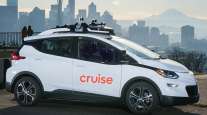Contributing Writer
Developers Take Varied Paths to Autonomous Trucking
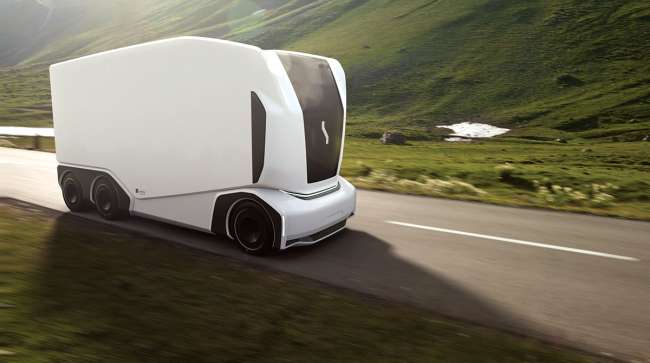
[Stay on top of transportation news: Get TTNews in your inbox.]
LONG BEACH, Calif. — Autonomous trucking is branching into multiple approaches and each has a different route to commercialization.
That was evident from two panel discussions on the development of self-driving trucks at the Advanced Clean Transportation Expo on May 11.
Paccar Inc., for example, is partnering with Aurora Innovation to build fully autonomous trucks to use in pilot programs such as its venture hauling freight for FedEx Corp., said Andy Weiblen, director of product planning and strategy for Paccar’s Peterbilt brand.
“We’re responsible for delivering the truck with all the controls and Aurora is responsible for delivering the (autonomous) driver,” Weiblen said.
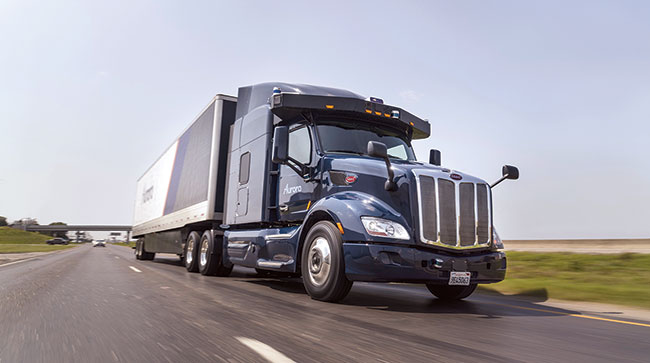
A Peterbuilt using Aurora self-driving technology. (Aurora Inc.)
Peterbilt trucks also are the platform for a similar autonomous trucking pilot with Waymo and UPS Inc.
The test programs are developing hub-to-hub trucking where humans pilot the vehicles on the first and last miles to and from highway-adjacent depots. Self-driving trucks would haul freight between the hubs on the major trucking lanes. The industry considers such a system a hybrid model.
“We are working with the fleets to understand how we can fit into their operation,” Weiblen said.
But there are other strategies.
Einride builds electric, heavy-duty freight pods that can move goods within an industrial site. The Swedish company’s vehicles lack a cab, windows and mirrors, have no manual controls such as steering wheels and pedals, and their sculpted fronts are designed for aerodynamics. They are targeted at contained environments such as their use at General Electric Appliances’ 750-acre Appliance Park campus in Louisville, Ky.
Although it’s easier for trucks to work autonomously in closed settings, it is still not simple, said Michelle Avary, Einride’s vice president of product strategy and government affairs.
“These are complicated industrial parks,” Avary said. “There are still a lot of trucks that are driven by humans. You’ve got pallet movers, forklifts and you often have live railroad lines coming in.”
But overall, there are fewer random and erratic events than an autonomous truck would encounter on highways or in dense urban areas, she said.
Plus, a Cupertino, Calif.-based startup, has a blended strategy. Trucks equipped with its PlusDrive are designed to operate in tandem with a human driver. Although PlusDrive can work at Level 4 autonomous driving — without human interaction — it is dialed down to partially automated hands-free, foot-free Level 2 driving.
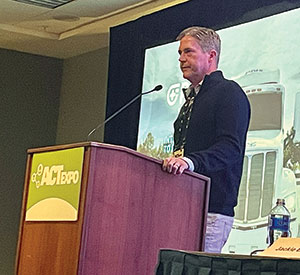
Plus' Kerrigan. (Jerry Hirsch for Transport Topics)
“It allows the driver to become a supervisor in highway driving conditions but also to jump in and manage the edge cases” that are challenging for current self-driving technology, said Plus COO Shawn Kerrigan.
The system logs the data from edge incidents so that Plus can expand the capabilities of its fully autonomous technology.
The approach will allow Plus to demonstrate the safety of its system over “billions of miles” before launching into full self-driving mode, providing public confidence in the technology, Kerrigan said.
Elsewhere, Pittsburgh-based Locomation plans to roll out a platooning model that relies on both human and robotic driving.
This system pairs two trucks in a convoy formation. A human drives the first vehicle. Like the Plus system, these trucks have autonomous driving capability, but it supports the lead driver rather than controls the convoy.
“The technology handles common driving tasks, but we are looking to the experienced human driver to recognize and react to the edge cases,” said Çetin Meriçli, Locomation’s CEO.
Digital connections and automated technology allow the second truck to follow closely. It also has a human driver who is sleeping or not actively driving to preserve operating hours allotted by the federal hours-of-service rules. Eventually, the trucks swap positions with the driver who was previously following taking control of the convoy.
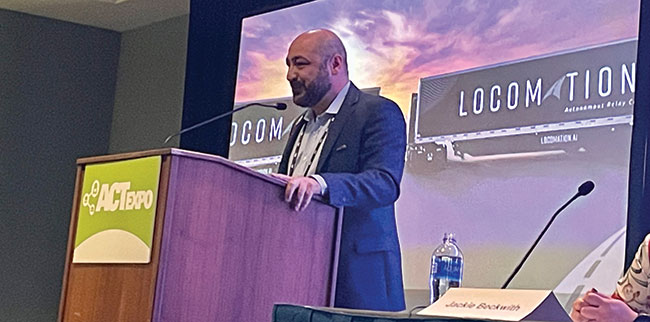
Meriçli describes Locomation's efforts. (Jerry Hirsch for Transport Topics)
This business model doubles capacity by offering up to 22 hours of continuous operation for both trucks, reduces greenhouse emissions and increases fuel economy thanks to the aerodynamic benefits of the convoy formation, Meriçli said.
He said it can be rolled out now as it is legal by federal regulations and 30 states.
The panelist said that on-highway autonomous driving still requires changes in both federal and state regulations. They all are seeking the federal government to step in and standardize self-driving truck regulations.
The industry is looking at other aspects of automation to pair with self-driving trucks.
Rocsys, a Dutch company with its U.S. office in Portland, develops automated charging systems for electric trucks.
Its first U.S. deal is at the Port of Oakland, where it will provide systems that autonomously charge part of the electric yard tractor fleet of SSA Marine. Drivers park yard tractors near charging stations that automatically find the vehicle’s charging port.
The company also wants to develop robotic charging systems that would travel through yards and depots, automatically charging electric trucks.
The systems could manage electricity demand to charge the vehicles at the least expensive times, or find the trucks that need to be charged the quickest to be ready for their next shift, said Erin Galiger, senior business development manager at Rocsys North America
They also can alleviate an expected shortage of charging infrastructure by servicing multiple trucks in quick succession.
“Instead of putting hundreds of chargers in the ground, we make sure to have high power chargers that can deliver that to hundreds of vehicles,” Galiger said.
Regardless of the pathway, all the panelists see a role for human truck drivers for many years to come. The panelists are looking at autonomous trucking to address the chronic shortage of drivers and growing freight demand.
Truckers will likely drive shorter routes and spend more time at home than the current cadre of drivers. And their jobs will become easier as automation augments human driving.
“Our view is that drivers who enter the profession today will retire as drivers,” Kerrigan said.
Want more news? Listen to today's daily briefing below or go here for more info:


